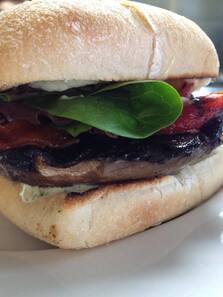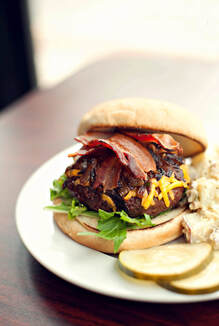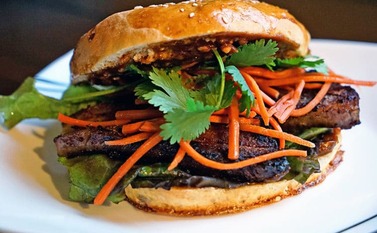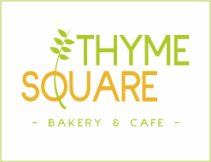
edition: winter
The beautiful, satisfying sandwich...

Dear friends & local food enthusiasts,
Happy Autumn!
I love autumn. Something about the colors, smells, and mild weather seems to get people relaxed and hungry!
Sandwiches are a big part of my business. The majority of our lunch menu revolves are this hand-held staple and I was curious: when did the sandwich come into being and when, exactly, did it become the American staple it is today? Lets check it out...

#1: the sandwich, defined
According to Wikipedia, a sandwich is a food typically consisting of vegetables, sliced cheese or meat, placed on or between slices of bread, or more generally any dish wherein two or more pieces of bread serve as a container or wrapper for another food type. Ok, that sounds about right.
The sandwich is named after its supposed inventor, John Montagu, 4th Earl of Sandwich. The Wall Street Journal has described it as Britain's "biggest contribution to gastronomy". Way to go Britain!
According to Wikipedia, a sandwich is a food typically consisting of vegetables, sliced cheese or meat, placed on or between slices of bread, or more generally any dish wherein two or more pieces of bread serve as a container or wrapper for another food type. Ok, that sounds about right.
The sandwich is named after its supposed inventor, John Montagu, 4th Earl of Sandwich. The Wall Street Journal has described it as Britain's "biggest contribution to gastronomy". Way to go Britain!

#2: the history, part 1
The modern concept of a sandwich using slices of bread (as found within the West) can be traced to 18th-century Europe. However, the use of some kind of bread or bread-like substance to lie under (or under and over) some other food, or used to scoop up and enclose or wrap some other type of food, long predates the eighteenth century, and is found in numerous much older cultures worldwide. The ancient Jewish sage Hillel the Elder is said to have wrapped meat from the Paschal lamb and bitter herbs in a soft matzah—flat, unleavened bread—during Passover in the manner of a modern wrap made with flatbread. Flat breads of only slightly varying kinds have long been used to scoop or wrap small amounts of food en route from platter to mouth throughout Western Asia and northern Africa. From Morocco to Ethiopia to India, bread is baked in flat rounds, contrasting with the European loaf tradition.
During the Middle Ages in Europe, thick slabs of coarse and usually stale bread, called "trenchers", were used as plates. After a meal, the food-soaked trencher was fed to a dog or to beggars at the tables of the wealthy, and eaten by diners in more modest circumstances. The first direct connection to the English sandwich was found in the Netherlands of the seventeenth century, where a man named John Ray observed that in the taverns, beef hung from the rafters "which they cut into thin slices and eat with bread and butter laying the slices upon the butter.”
The modern concept of a sandwich using slices of bread (as found within the West) can be traced to 18th-century Europe. However, the use of some kind of bread or bread-like substance to lie under (or under and over) some other food, or used to scoop up and enclose or wrap some other type of food, long predates the eighteenth century, and is found in numerous much older cultures worldwide. The ancient Jewish sage Hillel the Elder is said to have wrapped meat from the Paschal lamb and bitter herbs in a soft matzah—flat, unleavened bread—during Passover in the manner of a modern wrap made with flatbread. Flat breads of only slightly varying kinds have long been used to scoop or wrap small amounts of food en route from platter to mouth throughout Western Asia and northern Africa. From Morocco to Ethiopia to India, bread is baked in flat rounds, contrasting with the European loaf tradition.
During the Middle Ages in Europe, thick slabs of coarse and usually stale bread, called "trenchers", were used as plates. After a meal, the food-soaked trencher was fed to a dog or to beggars at the tables of the wealthy, and eaten by diners in more modest circumstances. The first direct connection to the English sandwich was found in the Netherlands of the seventeenth century, where a man named John Ray observed that in the taverns, beef hung from the rafters "which they cut into thin slices and eat with bread and butter laying the slices upon the butter.”

# 2: the history, part 2
Initially perceived as food that men shared while gaming and drinking at night, the sandwich slowly began appearing in polite society as a late-night meal among the aristocracy. The sandwich's popularity in Spain and England increased dramatically during the nineteenth century, when the rise of industrial society and the working classes made fast, portable, and inexpensive meals essential.
In London, for example, at least seventy street vendors were selling ham sandwiches by 1850; during that decade sandwich bars also became an important form of eating establishment in western Holland, typically serving liver and salt beef sandwiches.
In the United States, the sandwich was first promoted as an elaborate meal at supper. By the early twentieth century, as bread became a staple of the American diet, the sandwich became the same kind of popular, quick meal as was already widespread in the Mediterranean.
Initially perceived as food that men shared while gaming and drinking at night, the sandwich slowly began appearing in polite society as a late-night meal among the aristocracy. The sandwich's popularity in Spain and England increased dramatically during the nineteenth century, when the rise of industrial society and the working classes made fast, portable, and inexpensive meals essential.
In London, for example, at least seventy street vendors were selling ham sandwiches by 1850; during that decade sandwich bars also became an important form of eating establishment in western Holland, typically serving liver and salt beef sandwiches.
In the United States, the sandwich was first promoted as an elaborate meal at supper. By the early twentieth century, as bread became a staple of the American diet, the sandwich became the same kind of popular, quick meal as was already widespread in the Mediterranean.

#3: the history, part 3
The first written usage of the English word appeared in Edward Gibbon's journal, in longhand, referring to "bits of cold meat" as a "Sandwich". It was named after John Montagu, 4th Earl of Sandwich, an eighteenth-century English aristocrat. It is said that he ordered his valet to bring him meat tucked between two pieces of bread, and others began to order "the same as Sandwich!" It is commonly said that Lord Sandwich was fond of this form of food because it allowed him to continue playing cards, particularly cribbage, while eating, without using a fork, and without getting his cards greasy from eating meat with his bare hands.
Before being known as sandwiches, this food combination seems to simply have been known as "bread and meat" or "bread and cheese". These two phrases are found throughout English drama from the sixteenth and seventeenth centuries.
In the United States, a court in Boston, Massachusetts, ruled in 2006 that a sandwich includes at least two slices of bread and "under this definition, this court finds that the term 'sandwich' is not commonly understood to include burritos, tacos, and quesadillas, which are typically made with a single tortilla and stuffed with a choice filling of meat, rice, and beans." The issue stemmed from the question of whether a restaurant that sold burritos could move into a shopping center where another restaurant had a no-compete clause in its lease prohibiting other "sandwich" shops.
The first written usage of the English word appeared in Edward Gibbon's journal, in longhand, referring to "bits of cold meat" as a "Sandwich". It was named after John Montagu, 4th Earl of Sandwich, an eighteenth-century English aristocrat. It is said that he ordered his valet to bring him meat tucked between two pieces of bread, and others began to order "the same as Sandwich!" It is commonly said that Lord Sandwich was fond of this form of food because it allowed him to continue playing cards, particularly cribbage, while eating, without using a fork, and without getting his cards greasy from eating meat with his bare hands.
Before being known as sandwiches, this food combination seems to simply have been known as "bread and meat" or "bread and cheese". These two phrases are found throughout English drama from the sixteenth and seventeenth centuries.
In the United States, a court in Boston, Massachusetts, ruled in 2006 that a sandwich includes at least two slices of bread and "under this definition, this court finds that the term 'sandwich' is not commonly understood to include burritos, tacos, and quesadillas, which are typically made with a single tortilla and stuffed with a choice filling of meat, rice, and beans." The issue stemmed from the question of whether a restaurant that sold burritos could move into a shopping center where another restaurant had a no-compete clause in its lease prohibiting other "sandwich" shops.
#4: World-wide sandwich varieties

Peru: Butifarra- Boiled ham with salsa criolla and cilantro or lettuce
Italy: Carrozza- Breaded & fried cheese sandwich
Russia: Caviar- Red caviar with butter on white bread, decorated with parsley
Uruaguay: Chivito- Filet mignon with mozzarella, tomato, mayonnaise, bacon, olives, fried egg and ham
Argentina: Morcipan- Grilled blood sausage on a crusty roll with salsa
Singapore: Har cheong gai burger- chicken fried with fermented shrimp paste
Trinidad and Tobago: Doubles- two, flat fired pieces of bread with curried chickpeas or garbanzo beans
India: Grilled Cottage Cheese: cottage cheese, green chutney, butter, and additional cheese on bread
France: Corque-monsieur: baked ham & gruyere cheese on brioche bread topped with mornay or bechemel sauce
Italy: Carrozza- Breaded & fried cheese sandwich
Russia: Caviar- Red caviar with butter on white bread, decorated with parsley
Uruaguay: Chivito- Filet mignon with mozzarella, tomato, mayonnaise, bacon, olives, fried egg and ham
Argentina: Morcipan- Grilled blood sausage on a crusty roll with salsa
Singapore: Har cheong gai burger- chicken fried with fermented shrimp paste
Trinidad and Tobago: Doubles- two, flat fired pieces of bread with curried chickpeas or garbanzo beans
India: Grilled Cottage Cheese: cottage cheese, green chutney, butter, and additional cheese on bread
France: Corque-monsieur: baked ham & gruyere cheese on brioche bread topped with mornay or bechemel sauce

Mmmm...hungry yet? I dont know. Some of those varieties are a little out of my comfort zone but a sandwich is definitely one of my go-to's.
As we enter the season of thankfulness, I would like to take the time to let you know how thankful I am for YOU! Your support and passion for good food keep me driven to always try harder and be better for all. I am thankful for my amazing staff, farmers, vendors, and business professionals. I would not be able to do what I love without you!
Finally, sandwich, I am thankful for you, as well. Not only are you at the epicenter of my business but you have nourished my body & soul more times than I can count. TO everyone, thank you, and I look forward to serving you a sandwich soon!
Until next time, eat well!
Best, Erica

